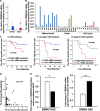Hypermethylation and decreased expression of TMEM240 are potential early-onset biomarkers for colorectal cancer detection, poor prognosis, and early recurrence prediction
- PMID: 32398064
- PMCID: PMC7218647
- DOI: 10.1186/s13148-020-00855-z
Hypermethylation and decreased expression of TMEM240 are potential early-onset biomarkers for colorectal cancer detection, poor prognosis, and early recurrence prediction
Abstract
Background: Gene silencing by aberrant DNA methylation of promoter regions remains the most dominant phenomenon occurring during tumorigenesis. Improving the early diagnosis, prognosis, and recurrence prediction of colorectal cancer using noninvasive aberrant DNA methylation biomarkers has encouraging potential. The aim of this study is to characterize the DNA methylation of the promoter region of TMEM240, as well as gene expression and its effect on cell biological functions and its applications in early detection and outcome prediction.
Results: Highly methylated CpG sites were identified in the TMEM240 gene by Illumina methylation 450K arrays in 26 Taiwanese patient paired samples and 38 paired samples from The Cancer Genome Atlas (TCGA) colorectal cancer dataset. Transient transfection and knockdown of TMEM240 were performed to demonstrate the role of TMEM240 in colorectal cancer cells. The data showed that TMEM240 could lead to G1 cell cycle arrest, repress cancer cell proliferation, and inhibit cancer cell migration. The quantitative methylation-specific real-time polymerase chain reaction (PCR) results revealed that 87.8% (480 of 547) of the colorectal cancer tumors had hypermethylated TMEM240, and this was also found in benign tubular adenomas (55.6%). Circulating cell-free methylated TMEM240 was detected in 13 of 25 (52.0%) Taiwanese colorectal cancer patients but in fewer (28.6%) healthy controls. In 72.0% (85/118) of tissue samples, TMEM240 mRNA expression was lower in Taiwanese CRC tumor tissues than in normal colorectal tissues according to real-time reverse transcription PCR results, and this was also found in benign tubular adenomas (44.4%). The TMEM240 protein was analyzed in South Korean and Chinese CRC patient samples using immunohistochemistry. The results exhibited low protein expression in 91.7% (100/109) of tumors and 75.0% (24/32) of metastatic tumors but exhibited high expression in 75.0% (6/8) of normal colon tissues. Multivariate Cox proportional hazards regression analysis found that mRNA expression of TMEM240 was significantly associated with overall, cancer-specific, and recurrence-free survival (p = 0.012, 0.007, and 0.022, respectively).
Conclusions: Alterations in TMEM240 are commonly found in Western and Asian populations and can potentially be used for early prediction and as poor prognosis and early-recurrence biomarkers in colorectal cancer.
Keywords: Circulating cell-free DNA; DNA methylation; Early detection; Early onset; Prognostic marker; TMEM240; ccfDNA; cmDNA.
Conflict of interest statement
There are no conflicts of interest.
Figures







Similar articles
-
Hypermethylation of TMEM240 predicts poor hormone therapy response and disease progression in breast cancer.Mol Med. 2022 Jun 17;28(1):67. doi: 10.1186/s10020-022-00474-9. Mol Med. 2022. PMID: 35715741 Free PMC article.
-
SMAD3 Hypomethylation as a Biomarker for Early Prediction of Colorectal Cancer.Int J Mol Sci. 2020 Oct 7;21(19):7395. doi: 10.3390/ijms21197395. Int J Mol Sci. 2020. PMID: 33036415 Free PMC article.
-
Genome-wide methylation profiling identified novel differentially hypermethylated biomarker MPPED2 in colorectal cancer.Clin Epigenetics. 2019 Mar 7;11(1):41. doi: 10.1186/s13148-019-0628-y. Clin Epigenetics. 2019. PMID: 30846004 Free PMC article.
-
DNA Methylation-Based Testing in Liquid Biopsies as Detection and Prognostic Biomarkers for the Four Major Cancer Types.Cells. 2020 Mar 5;9(3):624. doi: 10.3390/cells9030624. Cells. 2020. PMID: 32150897 Free PMC article. Review.
-
Value of methylation markers in colorectal cancer (Review).Oncol Rep. 2021 Aug;46(2):177. doi: 10.3892/or.2021.8128. Epub 2021 Jul 2. Oncol Rep. 2021. PMID: 34212989 Review.
Cited by
-
Promising Epigenetic Biomarkers for the Early Detection of Colorectal Cancer: A Systematic Review.Cancers (Basel). 2021 Oct 2;13(19):4965. doi: 10.3390/cancers13194965. Cancers (Basel). 2021. PMID: 34638449 Free PMC article. Review.
-
Genomic and Transcriptomic Research in the Discovery and Application of Colorectal Cancer Circulating Markers.Int J Mol Sci. 2023 Aug 3;24(15):12407. doi: 10.3390/ijms241512407. Int J Mol Sci. 2023. PMID: 37569782 Free PMC article. Review.
-
Genome-Wide Methylation Profiling of lncRNAs Reveals a Novel Progression-Related and Prognostic Marker for Colorectal Cancer.Front Oncol. 2022 Jan 20;11:782077. doi: 10.3389/fonc.2021.782077. eCollection 2021. Front Oncol. 2022. PMID: 35127488 Free PMC article.
-
The Facilitation of Clinical and Therapeutic Discoveries in Myalgic Encephalomyelitis/Chronic Fatigue Syndrome and Related Diseases: Protocol for the You + ME Registry Research Platform.JMIR Res Protoc. 2022 Aug 10;11(8):e36798. doi: 10.2196/36798. JMIR Res Protoc. 2022. PMID: 35816681 Free PMC article.
-
Liquid Biopsy and Colorectal Cancer.South Asian J Cancer. 2025 Jan 2;13(4):246-250. doi: 10.1055/s-0044-1801753. eCollection 2024 Oct. South Asian J Cancer. 2025. PMID: 40060351 Free PMC article. Review.
References
-
- Taiwan Ministry of Health and Welfare. 2018 Taiwan health and welfare report. 2019.
-
- Ferlay J, Soerjomataram I, Ervik M, Dikshit R, Eser S, Mathers C, Rebelo M, Parkin D, Forman D, Bray F. GLOBOCAN 2012 v1.0, Cancer incidence and mortality worldwide: IARC CancerBase No. 11 [Internet]. Lyon, France: International Agency for Research on Cancer; 2013. Available from: http://globocan.iarc.fr, accessed on 13/12/2013.
Publication types
MeSH terms
Substances
LinkOut - more resources
Full Text Sources
Other Literature Sources
Medical
Molecular Biology Databases
Research Materials

